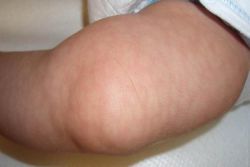Why does a newborn have marbled skin? Marbling of the skin - causes.
A newborn baby has especially delicate skin that is easily injured. The baby's skin should be handled very carefully and carefully, as it is easily damaged. Such soft skin prone to many diseases, one of which includes marbled skin in infants.
Marbled skin is considered a common disease in newborns. The baby's skin becomes marbled and takes on a mottled hue due to incompletely formed tissues near the surface. blood vessels. Many of them begin to narrow and give light blue shade, and the rest expand and add red.
All this leads to the formation of a marble mesh, which appears when the temperature in the room is cool at the time of changing clothes. This disease occurs due to a violation of the microcirculation of blood moving in the smallest vessels - capillaries.
But in some children, this color can also indicate serious abnormalities - such as intracranial pressure, cerebral edema, or disorders of the central nervous system.
Causes
Marbled skin in a child occurs due to many reasons.
- Breast-feeding for a long time. The marble pattern in this case can arise due to overload of small vessels with blood. Breast milk in large quantities, which the baby consumes at one feeding, causes the blood vessels to remain stretched for a long time, as a result of which they lose their elasticity, and their contours are visible through the baby’s light skin.
- Autonomic dysfunction that disrupts vascular tone. This disease can occur when protracted labor, since the head and cervical spine at the time of childbirth receive a very large load, which increases with prolonged labor.
- Pathological causes, anemia and hypoxia in a child during pregnancy. Such deviations negatively affect the child’s blood circulation, causing illness even at intrauterine development.
- Heart diseases. Children who have a marbled color are sent for examination to a neurologist and a cardiologist to identify possible cardiovascular abnormalities.
- Heredity. Marbled skin in a baby can be passed on from one of the parents suffering from heart disease.
- Congenital disease. The causes of marbling are congenital telangiectatic patterns. Most often, this disease affects children living in cold climates.
- Fever. If the child’s temperature rises to 39 degrees or higher, the skin may acquire a marbled tint, as heat transfer is disrupted and blood vessels spasm.
- Down syndrome. In children who are born special, the mesh pattern is a very common phenomenon.
Marble color does not fade into adult life. For some children it may go away within a few months, and for others it may take several years. To return the normal shade it is enough proper nutrition, regular walks and observation by a doctor.
For normal blood circulation, the child must grow at a favorable temperature without changes.
How to treat
Marbled skin in a child in many cases does not contain severe consequences and goes away when the baby grows up. With growing up, vegetative nervous system becomes stronger and begins to regulate the condition of the vessels located under the skin, which as a result takes on a normal pink color. 
Treatment of marbled skin is to ensure a healthy lifestyle for the baby.
- Regular and proper massage, gymnastics. Parents can be taught this at the physical therapy office.
- Swimming. Children should visit swimming pools regularly.
- Daily walks fresh air.
- The baby should not be overheated or overfed.
A neurologist should be contacted immediately if marbled skin is accompanied by the following concerns:
- crying for no reason;
- irritability;
- sleep and appetite disturbances;
- blueness of the lips and nasolabial triangle.
These concerns may indicate serious medical conditions.
A mesh pattern can appear in every baby even without disease. Its appearance can be promoted by physical activity - for example, strong crying, bright skin and thinness, as well as temperature changes at the time of changing clothes. In this case, it takes on a normal shade when the child stops crying or warms up.
The presence of a marble shade can cause great anxiety among parents, but this is not a reason to panic. You should observe the child when it occurs and when it goes away, and then seek advice and identify deviations from a specialist.
Skin healthy newborn baby ones are particularly soft and elastic. So, if you collect a fold, the skin almost immediately takes on its previous appearance. The tenderness of the skin is easily explained by the fact that when the baby was in the mother’s tummy, its skin was covered with a layer of thick, special lubricant, which protected the skin throughout pregnancy from the effects of amniotic fluid.
Regarding color skin, then normally they can have shades from bright pink to pale red. But marbled skin in a baby, in some cases, indicates the presence of pathology.
Reasons for having a marbled pattern on the skinThe main and most harmless reason why a child’s skin becomes marbled is hypothermia. Observed this phenomenon mainly when changing a child's clothes, when it happens sharp drop temperatures, and the body, due to the imperfection of the thermoregulatory system, reacts by developing a marble pattern on the skin. However, there are other reasons why a baby’s skin becomes marbled.
The main one is excess load blood vessels. Thus, due to a lack of subcutaneous fat, a characteristic network of blood vessels is visible through the baby’s thin skin, which provides the marble color of the baby’s skin. This fact cannot be attributed to a pathological phenomenon, because Over time, the vessels adapt to the load, and the pattern disappears on its own.
Some pediatricians explain the presence of marbled skin in one month old baby in the following way. As a result of prolonged breastfeeding, in the presence of good lactation, the baby attaches well to the breast, which also increases the load on the blood vessels due to the large blood flow. As a result, a marble pattern appears on the skin.
The next reason why a child may have marbled skin is autonomic dysfunction. Its occurrence is observed in cases where birth process lasts quite a long time, as a result of which the cervical spine and the baby’s head are subjected to heavy load. The result of such childbirth may be autonomic vascular dysfunction, which is accompanied by the appearance of a marble pattern on the skin.
Often marbling of the skin is the result of the presence or during pregnancy. Problems of this kind can negatively affect the health of the baby.
We must also not forget that in some cases this pattern on the skin may be individual feature. Most often observed in those children who live in cold climates. In such cases, we can talk about pathology only when a change in the color of the skin is accompanied by the addition of other symptoms and signs, which may be irritability, tearfulness, etc. If they are present, it is necessary to consult a neurologist,  who will tell mom what needs to be done.
who will tell mom what needs to be done.
In most cases, the presence of such a pattern on the skin does not require any intervention from doctors. In 94 out of 100 children, marbling disappears on its own by the third month of life. It is by this time that the vessels return to normal. However, if at this point the child still has marbled skin, then the mother should consult a doctor about this. It is quite possible that its presence is a symptom of some pathology that requires medical intervention.
A disease such as marbled skin in a newborn is quite common and has characteristic symptoms. The skin of a newly born baby is tender, velvety, elastic, with an abundant blood supply. A baby's skin can be easily damaged, so even when caring for it, you need to be careful. For example, under no circumstances should you rub your baby with a towel, but only gently blot it dry. Negligent treatment of the baby's dermis can lead to the formation of diaper rash and small pustules. But marbling of the skin in infants is due to other factors.
Symptoms of pathology
With this disease, the skin of children becomes marbled or spotted due to large quantity blood vessels that have not formed and are located too close to the surface of the skin. Some vessels narrow, causing a blue color to appear, while others dilate, resulting in a red color.
Doctors associate the appearance of this disease with shortcomings in the activity of the central nervous system. Marbled skin in a baby can also indicate the development of pathologies such as hydrocele, high intracranial pressure and the presence of a cyst.
Return to contents
Factors provoking the disease
The reasons why the disease may appear are quite extensive. Most often, the development of pathology occurs due to the following factors: 
- Long-term feeding. If the baby stays for a long time mother's breast and overfeeding occurs, a marble pattern appears on the skin due to the fact that the blood vessels are oversaturated with blood. If milk enters the baby’s body in large quantities, this can lead to stretching of the walls of blood vessels, which leads to a loss of their firmness and elasticity.
- Violation of vascular tone. Marbled skin especially affects babies whose labor took too long. This is why there are injuries to the head and part of the spine in the neck due to additional stress.
- Anemia and hypoxia during pregnancy. The presence of such phenomena in women has bad influence on the baby's circulatory system.
- Heart diseases. Marbling in newborns can also indicate heart pathologies. For this reason, after birth, the child is referred not only to a neurologist, but also to a cardiologist for examination.
- Heredity. The phenomenon can be inherited from one of the parents if he suffers from vegetative-vascular dystonia.
Return to contents
Can marbling be considered normal?
If the appearance of marbling of the skin is a periodic phenomenon in the baby and appears only with hypothermia and overfeeding, then it can be argued that this is a relatively normal condition, but requires additional observation.
Most often, this phenomenon disappears by six months, when the vessels can independently maintain their tone and not be influenced by external factors.
 But if vascular network on the epidermis of the baby is very pronounced and this causes alarm, then you need to pay attention to the following additional signs:
But if vascular network on the epidermis of the baby is very pronounced and this causes alarm, then you need to pay attention to the following additional signs:
- frequent sweating (in normal conditions, babies should not sweat at all, because their thermoregulation is not yet as well developed as that of adults, so the appearance of sweat in a child who has recently been born is an alarming sign);
- the manifestation of two opposites is possible - lethargy or hyperexcitability;
- bluishness of the lips and the triangle around them and the nose;
If the baby has marble mesh, it is necessary to constantly measure the baby’s temperature (such signs may indicate hyperthermia) and call a doctor.
Return to contents
Treatment in a child
Often this phenomenon does not pose any danger to the child’s life. With age, the baby's skin hardens along with the subcutaneous vessels. In addition, the nervous system is finally formed. But despite everything, doctors recommend bringing the baby for additional examination to a neurologist.
If the manifestation of the vascular network causes mistrust in the doctor, then he should prescribe additional examinations: Ultrasound of the head, neurosonography. In addition, there are diseases of the dermis in children, for which characteristic feature there is marbling.
 If the manifestation of the vascular network is not associated with severe pathologies, then the manifestation of this disease can be reduced. To do this, it is necessary to organize such living conditions for the baby that will support him vascular system in good shape. These conditions include:
If the manifestation of the vascular network is not associated with severe pathologies, then the manifestation of this disease can be reduced. To do this, it is necessary to organize such living conditions for the baby that will support him vascular system in good shape. These conditions include:
- regular massages;
- classes special gymnastics which can be carried out by both a specialist and the parents themselves;
- spending a long time outdoors;
- regulation of nutrition to avoid overeating by the baby;
- Overheating is contraindicated for babies who are prone to developing marbled skin.
In addition, parents need to know about this form of marbled skin, which is congenital. With this feature of the baby’s skin, the network of blood vessels does not go away, even if the baby is warmed up.
Marbled leather is a common occurrence in children who live in a cold room.
The phenomenon of a bright vascular network may also indicate a number of congenital diseases:
- generalized phlebectasia, in which vascular defects and skin atrophy are diagnosed;
- congenital syphilis.
Sometimes a marbled shade of the skin can appear with Down and Edwards syndromes. If the vascular network appears on lower limbs, then this may indicate atopic dermatitis.
From all of the above, we can conclude that marbled skin is not a disease, but a temporary phenomenon that is caused by the underdevelopment of the baby’s blood vessels or is a symptom of some serious illness. Therefore, if the vascular network appears quite often and intensely, then to be on the safe side it is better to consult a doctor.
Marbled skin in infants, or dyschromia, is a reticular or tree-like vascular pattern of blue-red shades on the skin. After the birth of a baby, many organs and systems of the body are not yet fully formed and take time to mature. This also applies to the skin - its vessels and nerves gradually adapt to external environment. Simply put, they “learn” to work correctly. There is no need to panic about this, but it is still worth drawing the attention of a doctor.
An openwork pattern on the body is often observed in children immediately in the first days of life or after some time. As a rule, this phenomenon goes away without any treatment within 3-6 months (sometimes after several years). This is due to the fact that the innervation of capillaries and venules of the skin (the smallest vessels) has not yet been adjusted, therefore, when the temperature in the external environment fluctuates, the vessels react chaotically - some of them narrow, and some expand. This creates a kind of spotting. More often, marbled skin in a newborn appears on the legs, less often on the arms, torso and face. Gradually, with the maturation of the baby’s nervous and vascular systems, as well as with the development of the subcutaneous fat layer, the vascular pattern disappears. However, the reasons for the marbled pattern on a child’s skin can be both natural and pathological.

Physiological features
Marbling is not a pathology if the vascular pattern is not pronounced and is episodic in nature. Treatment of physiological marbling is symptomatic. Reticulation can occur for many reasons:
- damage to skin vessels during childbirth;
- physical activity (for example, crying);
- overfeeding (according to some doctors, long feeding leads to an increase in the volume of circulating blood, and small vessels, stretching, lose their elasticity);
- cooling the skin while changing clothes;
- prematurity;
- asthenic physique (thinness);
- bright skin.

Pathological causes
If you see that the vascular pattern becomes more pronounced, does not disappear after warming and does not decrease as the child grows older, you need to consult a cardiologist and neurologist. Marbled skin in a baby may have several pathological reasons. Here are the most common:
- Fever. At high temperatures (about 40 degrees), the skin often acquires a marbled pattern due to spasm of blood vessels and impaired heat transfer from the body. This may be due to a bacterial infection.
- Fetal hypoxia. Lack of oxygen during pregnancy and childbirth sometimes has Negative influence
- on the development of the child’s nervous and vascular systems.
- Prolonged labor.
- During prolonged labor, the cervix and head of the fetus are subjected to prolonged stress, which may result in the appearance of autonomic dysfunction (improper functioning of the nerves responsible for the automatic functioning of internal organs). With some heart defects, such a vascular pattern is observed.
- Hydrocephalus (water on the brain), intracranial pressure, cyst. In such cases, marbled skin is just one of the symptoms, so do not rush to draw your own conclusions. Along with this there are bad dream And lack of appetite, constant crying, anxiety, etc. In any case, such a diagnosis can only be made by a doctor after a comprehensive examination.
- Heredity. If one or two parents have vegetative-vascular dystonia (VSD) and, as one of the symptoms, marbled skin, then with a high degree of probability the child will inherit this disease.
- Down syndrome, Edwards syndrome. In babies born special, marbling of the skin is a common occurrence.
- Generalized phleboectasia. A congenital form of the disease, in which the pattern on the skin is clearly pronounced and persists under any conditions.
If the marbled skin color of a baby is combined with high temperature body, cold extremities, vomiting, drowsiness and lethargy, difficulty breathing, convulsions, stiff neck (inability to bring the chin closer to the chest) - call an ambulance immediately!

What can you do at home?
In any case, whether your baby has a pathology or not, there are some tips on how to treat marbled skin at home:
- normalize temperature regime in room;
- change your baby's clothes only with warm hands;
- after water procedures The baby should not be wiped terry towel, but with a soft cotton diaper, so as not to damage the epithelium and thin vessels of the skin;
- dress according to the weather - do not overheat or overcool the child;
- pay attention to the baby’s nutrition - perhaps he lacks some vitamins or iron;
- ensure, if possible, daily long sleep in the fresh air;
- do massage and exercises regularly;
- swimming will help tone blood vessels and improve their functioning;
- arrange daily air baths- first half a minute, then the residence time should be gradually increased (the air in the room should have a temperature of 23 degrees).

Marbled skin as an independent disease
Congenital telangiectatic marbled skin (congenital generalized phleboectasia) is a poorly understood disease of the vascular system. Rarely seen. It is characterized by a bright marble pattern, which is constantly present - from birth and in any conditions. Moreover, when crying and others physical activity it may even intensify. Reticulate or tree-like pigmentation may appear partially (usually on the legs) or cover the entire body.
Scientists still have not figured out the cause of this disease. It is known to occur equally in both boys and girls. As a rule, there is no more than one case of phlebectasis in a family, that is hereditary factor unlikely.
Often congenital marbled skin is combined with body asymmetry as a result of disturbances in the development of the musculoskeletal system, the so-called. " wine stains"and "Mongolian spots", glaucoma. In some cases, concomitant phenomena such as retinal detachment, hydrocephalus, seizures, macrocephaly, lag in psychomotor development, epilepsy.
There is no special treatment for this pathology, so they treat here associated symptoms. The prognosis for congenital generalized phleboectasia is usually favorable - already during the first years of life the vascular pattern becomes lighter, and by adolescence The epidermis may even acquire a normal color.
Marble skin in a baby always causes concern for parents, but do not rush to panic - be patient and watch. Be sure to consult a doctor who will either dispel your fears or identify the disease in time, and you can correct the situation as early as possible.
Marbled skin in a baby is a rare phenomenon. But every parent who happened to encounter the spectacle of their child’s skin being covered with a red-violet mesh had to go through a lot of anxiety before they found out the cause of such an anomaly. There is no need to panic unnecessarily when marbling of the skin of a baby is detected, but the source of such a reaction of the epidermis still needs to be clarified. The culprit of marbling of the skin can be both physiological and pathological processes circulatory system child. And if oh physiological reasons There is no need to worry about the occurrence of marbling of the skin in newborns, then pathological condition
will need treatment. We will explore what marble disease is, its symptoms, causes and treatment.
What is the difference between marbling disease and marbling of the epidermis in infants? Due to similar terminology, many consider marble disease and marbled skin color in a newborn to be an identical pathology. But at their core, these deviations have different pathogenesis. What is marble disease? Very dangerous pathology , such as marbled osteopetrosis disease, is characterized by diffuse induration, due to which bone marrow hematopoiesis is disrupted, and the bones themselves become brittle. The disease osteopetrosis is a fatal diagnosis, because there is no medicine that completely cures this disease. And the children suffering from this genetic abnormality, rarely survive to the age of a teenager.
Early diagnosis marble disease in children allows you to control pathological process, expressed by bone fractures, improper fusion, skeletal deformation and other disorders. Deadly marble is observed on a section of the affected bone, hence the name of the disease.
Marble musculoskeletal disease is caused by a genetic abnormality, which is expressed in excessive formation of bone tissue.
Skin marbling infants- this is a completely different pathology and it is associated with an imbalance of the vascular system. The causes of marbling of the skin in a child can be physiological or pathological. This determines whether the baby needs to be treated for vascular pathology or marbled skin in a baby is a temporary phenomenon.
Physiological causes of marbled skin in children
Sometimes, due to the peculiarities of physiology, specific child has a vascular system that is located close to the surface of the skin. In addition, marbled skin in a child may be a consequence of imperfect thermoregulation. So when the temperature changes environment especially as it gets colder, the baby may experience marbling of the skin. The pattern is especially pronounced in the peripheral zone of blood circulation, that is, on the baby’s legs and arms.

Among probable causes Pediatricians also note the occurrence of marbling of the skin in an infant due to overeating. If the newborn eats breast milk or more infant formula than his age requires, then the blood volume is multiplied. An insufficiently strengthened capillary system lacks the tone to cope with a large volume of blood flow, and the skin of a newborn is very thin.
All these factors lead to the fact that capillary mesh becomes visible.
Children predisposed to manifestations of marbling on the skin:
- Born as a result of a protracted labor with complications.
- Which during childbirth had a strong load on the cervical spine and head.
- Those who experienced oxygen starvation during pregnancy or during childbirth.
- Those who have had intrauterine infection.
- Those born before their due date.
Another reason for marbling of a child’s skin is heredity. If one of the parents, or especially both, has vegetative-vascular disorders, then this pathological condition can be inherited by the child with a high degree of probability. Vegetovascular dystonia is not a disease, but rather a syndrome. VSD can accompany a person throughout his life, resulting in a neurohumoral disorder of the cardiovascular system.
Vegetative-vascular dystonia does not require special treatment; you will need to teach the child from the very beginning early age To healthy image life and nutrition. The correct daily routine, hardening and sporting events. The marbling of the skin of a baby in the first months of life should disappear on its own when it reaches six months of age. If the marble vascular pattern does not go away, then this is an eloquent sign the presence of cardiac or vascular pathology. But it is better, of course, not to wait for six months to check whether the marbled skin will go away or not, but to check with a doctor in advance about the reasons for such a vascular reaction of the body.
Pathological causes of marbling of the skin in a child
Physiological marbling of the baby’s skin does not require treatment. If the room is cool, then it is enough to rub the baby’s skin or dress him warmer so that the skin tone is restored. In the case where the cause of the appearance of a vascular pattern on the baby’s body is overfeeding, you just need to reduce the portions of food or increase the intervals between feedings and everything will go away. But when, regardless of the above measures, the symptoms of marbled skin in a newborn do not disappear, then it is worth taking a closer look at your child to detect signs of cardiovascular pathology.
Alarming symptoms of pathological marbling of a child’s skin:
- Increase or decrease in body temperature.
- Profuse sweating.
- Excited state.
- Marked lethargy.
- Head tilting.
- Blueness in the area of the nasolabial triangle.
- Along with the burgundy-purple vascular pattern, the underlying skin tone is pale.
These symptoms may indicate the following pathologies:
- Progression of anemia.
- Congenital pathologies.
- Genetic abnormalities.
- Perinatal cephalopathy.
- Increased intracranial pressure.
- Heart defects or congenital vascular abnormalities.
- Bone formation disorder (rickets).
In a situation where marbling of the skin of a newborn is associated with pathologies, it will be necessary to determine the specific source of the problem. The attending physician must prescribe full examination baby.
And based on the results of a thorough examination of the baby’s body, it is necessary to prescribe individual therapy.
Most often, the cause of many pathologies is oxygen deficiency in intrauterine development or asphyxia, which occurs during difficult and protracted labor. Even short-term hypoxia during pregnancy or lack of oxygen during prolonged labor activity, can lead to unpredictable neurological disorders in a child, including vascular disorders in the form of marbled skin.
If the reason for the marbling of the skin is in the physiology of the baby, then the task of the parents is to take care of the full formation of vascular tone in their child. This goal can be easily achieved thanks to regular massage manipulations, frequent and long walks in the fresh air, moderate exercise, swimming and other useful activities. It's important to remember that strong immunity and healthy habits established from childhood will reward the efforts of parents throughout full life their children.






